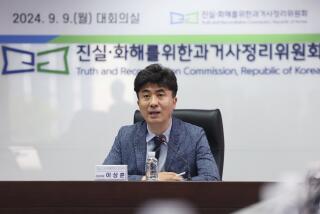Torn between two lands
- Share via
YUZHNO-SAKHALINSK, RUSSIA — Pak Den-dya has lived as an outsider in this hardscrabble land in the frigid North Pacific -- never taking Soviet or Russian citizenship in the 68 years since the Japanese empire uprooted her from her native Korea.
“I didn’t want to get citizenship because I wanted to go back to Korea,” said Pak, leafing through faded family photos of picnics and weddings on Sakhalin Island, where she was brought with her parents from then-Japanese-occupied Korea when she was just a year old. “Now, I will go there to die.”
Pak, 69, is in the last group of Koreans heading home under a program that aims to write the final chapter in an often-overlooked tragedy that befell tens of thousands of Koreans. But the ending is bittersweet at best.
Only Koreans born before World War II ended in August 1945 are eligible for relocation and financial support under the three-year repatriation program funded by South Korea and Japan. As a result, families are being torn apart again, much as they were by their forced move decades ago.
“I’m confused between happiness and sorrow,” said Pak, a widow who will leave behind four grown children and their families.
Starting in the 1920s, about 150,000 Koreans were taken 1,000 miles from North Gyeongsang province in Korea to the southern half of Sakhalin, off Siberia’s coast, then controlled by the Japanese. The province was chosen possibly to prevent the Koreans living near Japan from inundating the Japanese mainland to find work.
The Koreans were pressed into coal mining, logging and construction. They worked in harsh conditions, amid the forests and mountains where brown bears roam and rivers teem with salmon.
After Japan lost World War II, the Soviet Union took over all of Sakhalin, including about 23,500 remaining Korean residents. Some of the Koreans had died in the war or from hard labor, and others had left.
Those still here were effectively stranded because the Soviets had no diplomatic relations with what became South Korea, the U.S.-aligned country home to their old province.
Sakhalin during the Soviet era was a “closed” border area, meaning outsiders needed special permission to enter. One of its many military bases housed the warplanes that in 1983 shot down Korean Air flight 007 for straying into Soviet airspace, killing all 269 people aboard.
In the 1950s and 1960s, the Soviets allowed communist North Korea to lure away several hundred of the Korean youth. Some of the brightest are believed to have gone in the false hope they could get back to South Korea.
Over time, many Sakhalin Koreans took Russian names -- Pak called herself Masha -- and tried to integrate into Soviet society. But they faced discrimination, with Moscow shuttering Korean-language schools in the 1960s. Only after the Soviet reforms known as perestroika in the 1980s were the Koreans again allowed to start learning their own language.
Today, about 30,000 Koreans live on Sakhalin, a harpoon-shaped island with an area about three-quarters that of South Korea and a population of about 547,000. The Koreans include the descendants of the original group and some who came later from parts of the former Soviet Union and North Korea.
The Korean cultural presence is strong in Yuzhno-Sakhalinsk, the island’s capital city of more than 170,000 people, nestled in a valley backed by mountains. Markets feature kimchi -- a Korean pickled dish -- and restaurants serve Korean cuisine.
About 2,000 of some 3,000 elderly who qualify for repatriation are choosing to go home, according to the South Korean Foreign Ministry.
Kim Bok-kon is an activist who at 60 is too young to be covered by the repatriation subsidy. A former city official, he plans to visit Japan to try to bring the Sakhalin Koreans’ case before courts there.
“We still haven’t been done right,” he said. “Someone has to take responsibility.”
Kim “Zoya” Bo-ja, 63, is moving but worries about leaving her children and grandchildren, and about who will lead the Korean music ensemble she has directed in an effort to teach the community about its roots.
“It’s very sad that we are not going with children but are heading away from them. It’s another separation,” Kim said in her apartment in a drab five-story, Soviet-style building, where she packed a box of candy for a final shipment to her grandchildren living in the Far East city of Khabarovsk.
Koreans began to return home after the 1991 Soviet collapse. In 2000, a group of 816 people -- also born before 1945 -- was brought to a settlement built for them in the South Korean city of Ansan.
For the latest group being resettled through 2009, Japan is providing airline tickets and some household appliances. South Korea is paying monthly pensions of about $550 and rent for apartments in Incheon, a port city across the country from their home province.
For Pak, even though it’s not exactly home, it will be a dramatic improvement in comfort. The move to modern South Korea means she’ll no longer have to stoke a wood-burning stove to withstand winter temperatures that can dip to 26 degrees below zero. Her Russian pension from her years as a construction worker is only 3,700 rubles, about $150 a month.
Requests for a broader and more generous program for resettling Koreans have been shelved as too expensive.
“We are doing our best within limits,” said Kazuki Iwamoto, a Japanese Foreign Ministry official. “We have no immediate plans to expand the eligibility.”
On Sakhalin, the quality of life has improved because of massive oil and gas projects exploiting offshore fields, bringing in crowds of international workers to the island, and some islanders can afford imported used cars and electronic goods. The island is no longer closed, and the main airport offers numerous direct flights to other Russian cities, Japan and South Korea.
As a result, younger Sakhalin Koreans express more willingness to stay, questioning what opportunities they would have in South Korea without fluency in the language.
Yelena Kim, 26, a Korean who teaches Japanese at a school where about a third of the 600 students are Korean, said the Japanese should not be held responsible for the misdeeds of their ancestors.
Still, she warily noted the nationalist tendencies in today’s Japan. She pointed to a world map the Japanese government sent to her class; it was dated 1999, with the southern half of Sakhalin still shown as part of Japan. Kim recolored the map to put the island firmly in Russian territory.
“I was born in Sakhalin, in Russia. My soul, my character is not Korean. . . . I don’t want to go [to] Korea because it’s not my country,” Kim said. “You need to live where your soul lies.”
More to Read
Sign up for Essential California
The most important California stories and recommendations in your inbox every morning.
You may occasionally receive promotional content from the Los Angeles Times.










